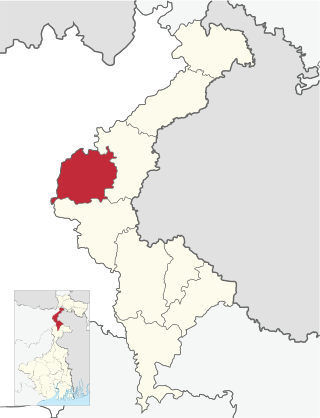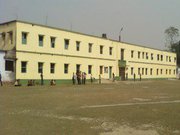
Balurghat (pron:bʌlʊəˈgɑ:t) is a city and a municipality in the state of West Bengal, India. It is the district headquarter of the Dakshin Dinajpur district. It is one of the major cities connected through National Highway 512. In this town there are museum, parks, super speciality hospital, govt. offices, district court, schools, colleges, a university, police station, railway station, hotels, restaurants, cinema halls, temples, mosques, churches, etc. There is the Atreyee river which flows through this town. It is a place/town to live peacefully. It is a place to visit in the month of October to November when one can enjoy ritualistic and religious festivals. From the inner area of Balurghat one can go Hilli, a rural area, where one can see India-Bangladesh border.

Uttar Dinajpur, also known as North Dinajpur, is a district of the Indian state of West Bengal. Created on 1 April 1992 by the division of the erstwhile West Dinajpur district, it comprises two subdivisions: Raiganj and Islampur.

Raiganj is a city and a municipality in the Indian state of West Bengal. It is the headquarters of the Uttar Dinajpur district. The police station was set up 125 years ago and railway connectivity reached the place 115 years ago. The city houses the 111-year-old Raiganj Coronation High School and more than 50-years-old government primary Raiganj Sarala Sundari GSFP School. Raiganj got its railway connection in 1896. The train used to go to Parbatipur junction in Bangladesh from Raiganj. It is a 200-year-old town.
Islampur is a city and a municipality in Uttar Dinajpur district in the Indian state of West Bengal. It is the headquarters of the Islampur subdivision.
Kaliaganj, also spelled as Kaliyaganj, is a town and a municipality in Uttar Dinajpur district in the Indian state of West Bengal. Kaliyaganj is a growing business and commerce region in North Dinajpur district, with rapid urbanisation and improved roadways.
Nachhratpur Katabari is a census town in Raiganj CD Block in Raiganj subdivision of Uttar Dinajpur district in the Indian state of West Bengal.
Kasba is a census town in Raiganj CD Block in Raiganj subdivision of Uttar Dinajpur district in the Indian state of West Bengal.

Goalpokhar I is a community development block that forms an administrative division in Islampur subdivision of Uttar Dinajpur district in the Indian state of West Bengal.

Karandighi is a community development block that forms an administrative division in Islampur subdivision of Uttar Dinajpur district in the Indian state of West Bengal. Jawahar Navodaya Vidyalaya, Dalkhola, Uttar Dinajpur was established in 2005. The school is temporariliy running at Teest Colony, Dalkhola, Uttar Dinajpur. It is adjacent to Primary Health Center, Dalkhola on NH 34. The land for the construction of permanent building has been transferred and construction work is about to start at Village Sima Anandapur of Panchayat Raniganj. The temporary site is about 3.5 Km from Dalkhola Railway Station.

Islampur subdivision is an administrative subdivision of the Uttar Dinajpur district in the Indian state of West Bengal. This subdivision was earlier a part of Bihar and was transferred to West Bengal with the passing of the States Reorganisation Act in 1956.
Chakulia is a gram panchayat with a police station of Islampur Police District in Goalpokhar II CD block in Islampur subdivision of Uttar Dinajpur district in the Indian state of West Bengal.
Chopra is a census town in Chopra CD Block in Islampur subdivision of Uttar Dinajpur district in the state of West Bengal, India.
Goalpokhar is a village in Goalpokhar I CD block in Islampur subdivision of Uttar Dinajpur district in the state of West Bengal, India.

Goalpokhar II is a community development block that forms an administrative division in Islampur subdivision of Uttar Dinajpur district in the Indian state of West Bengal.

Islampur is a community development block that forms an administrative division in Islampur subdivision of Uttar Dinajpur district in the Indian state of West Bengal.

Shree Agrasen College, established in 1995, is the general degree college in Dalkhola, in the Uttar Dinajpur district. It offers undergraduate courses in arts and commerce.
Karandighi is a village in Karandighi CD block in Islampur subdivision of Uttar Dinajpur district in the state of West Bengal, India.
Hemtabad is a village in Hemtabad CD block in Raiganj subdivision of Uttar Dinajpur district in the state of West Bengal, India.
Itahar is a census town in Itahar CD block in Raiganj subdivision of Uttar Dinajpur district in the state of West Bengal, India.
Hanskunda is a census town in Goalpokhar I CD Block in Islampur subdivision of Uttar Dinajpur district in the state of West Bengal, India.




















